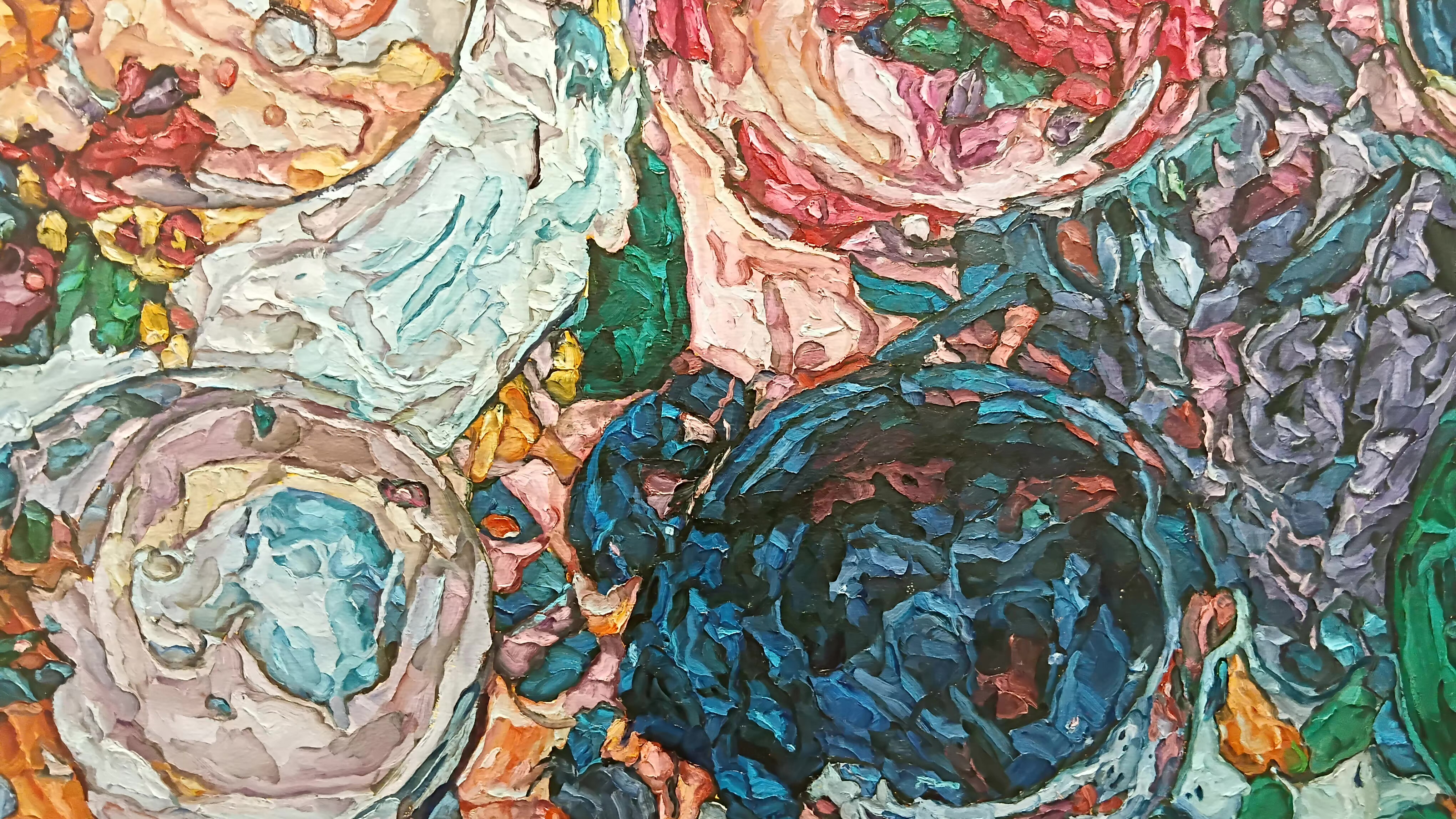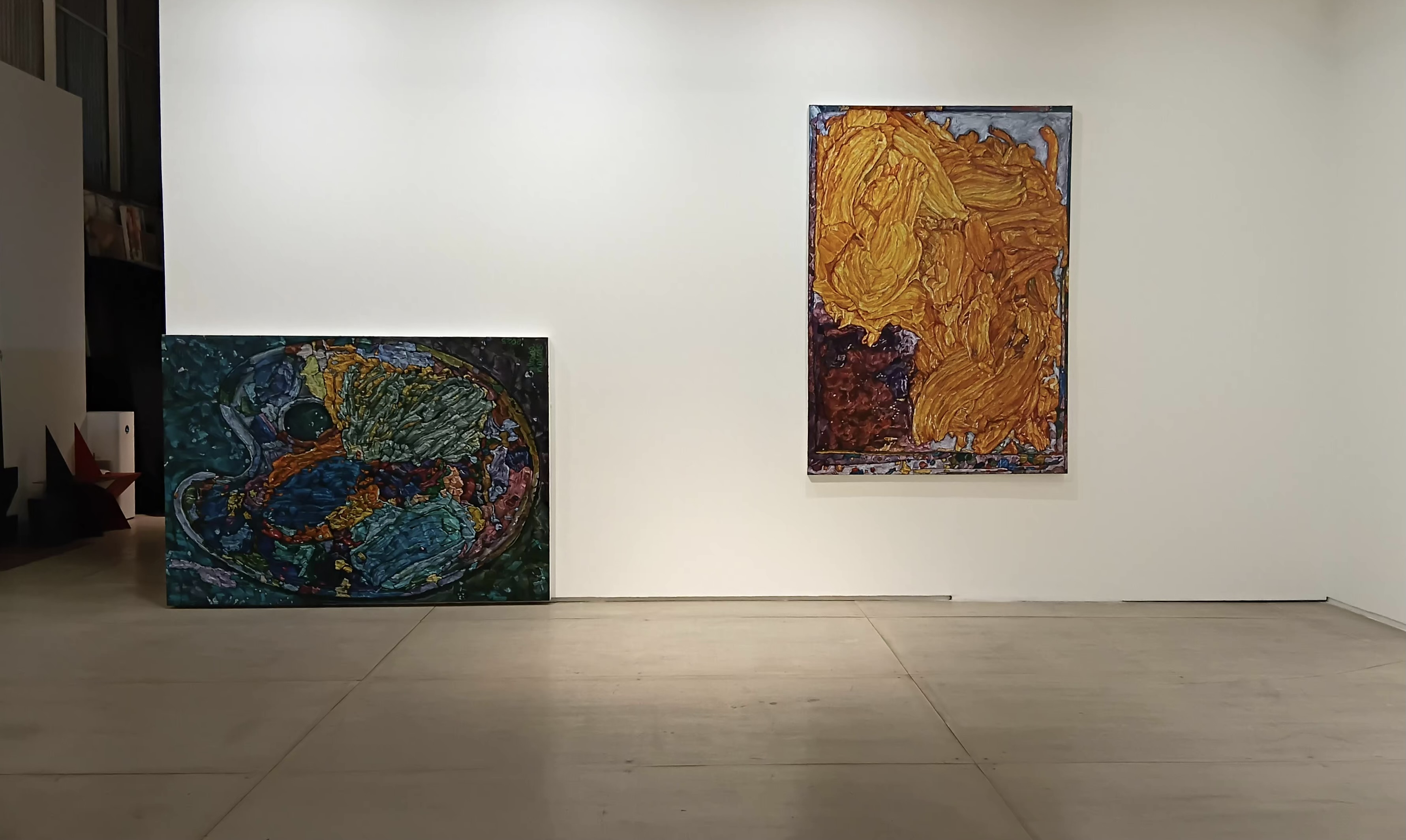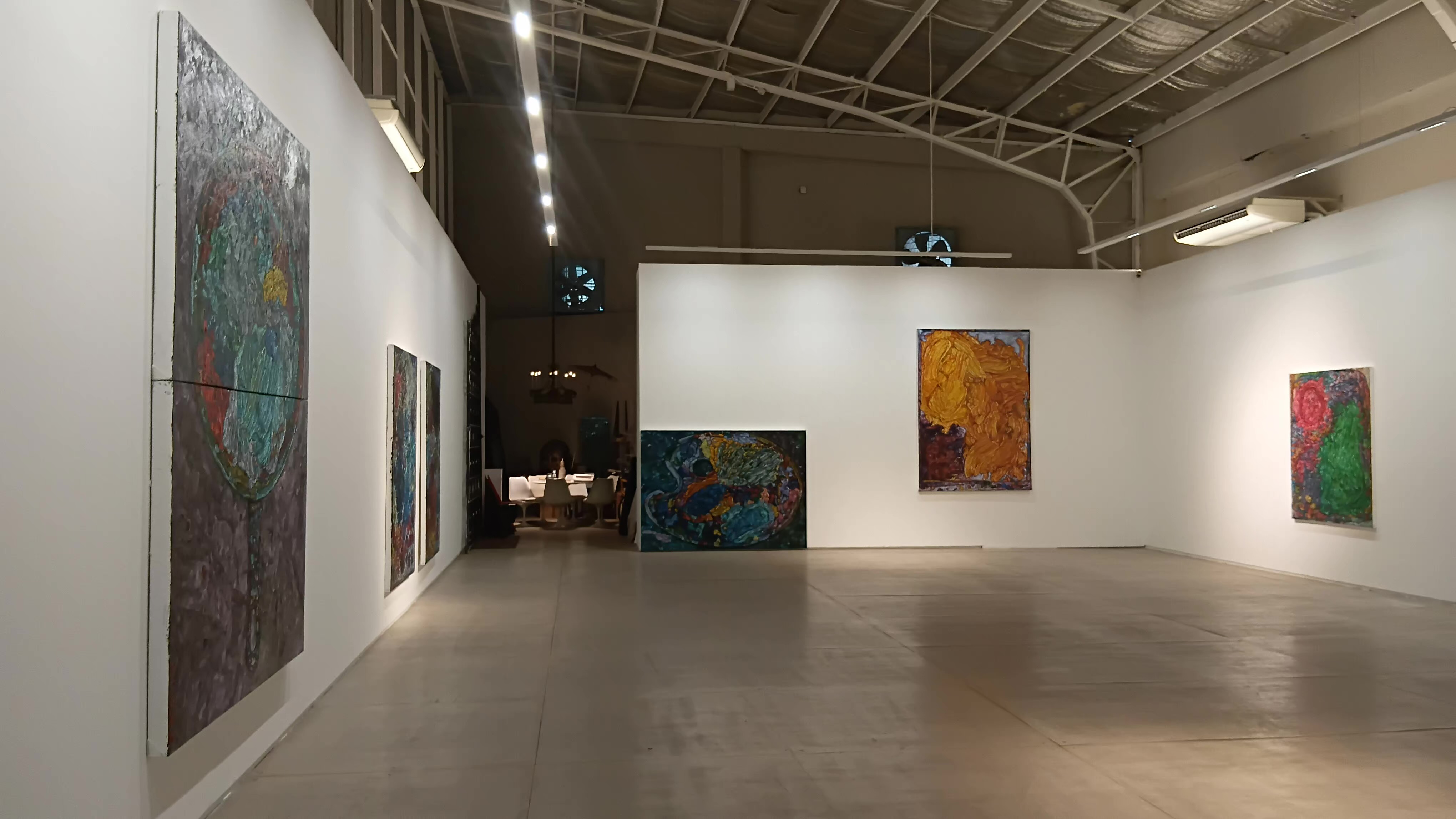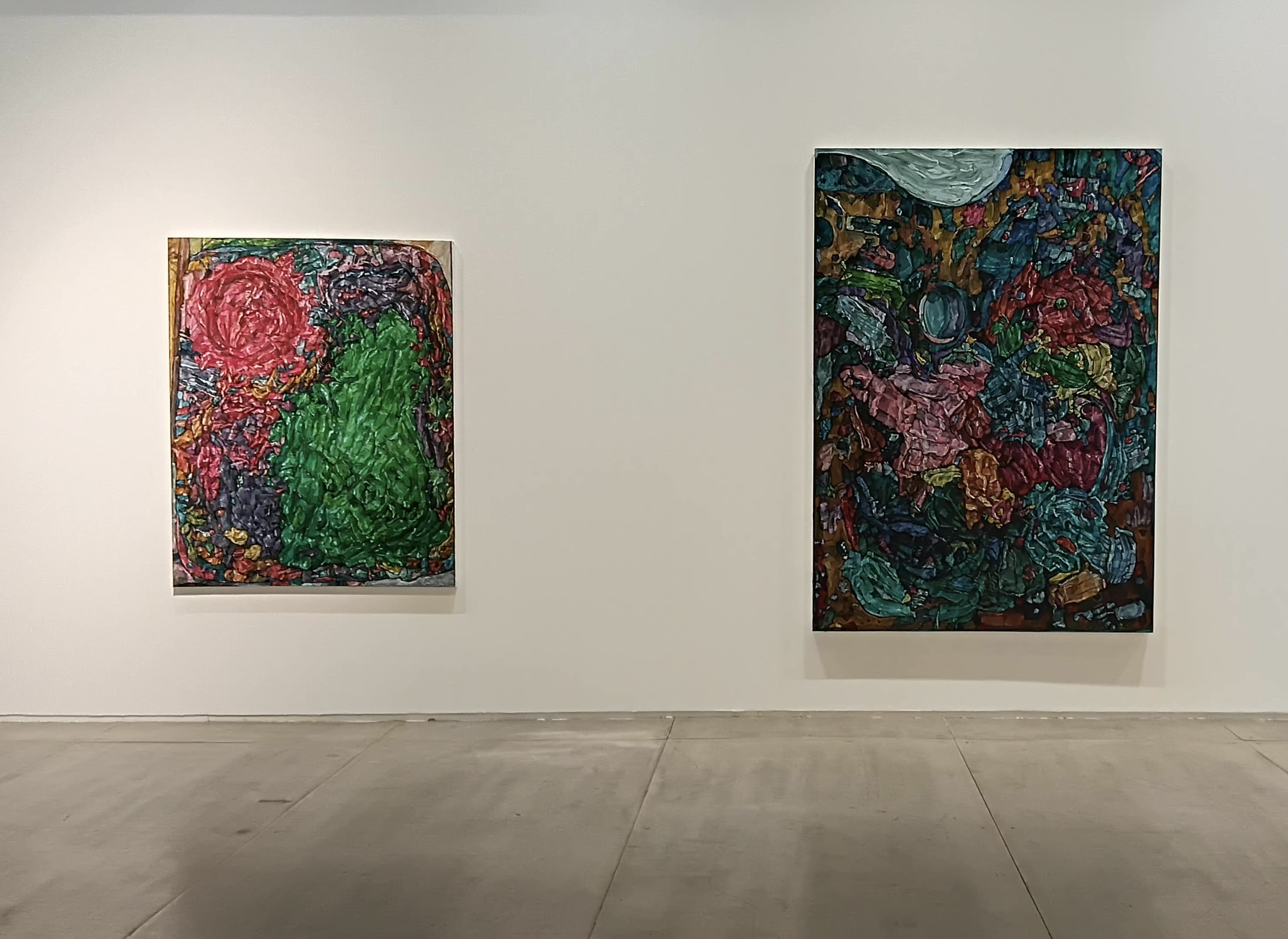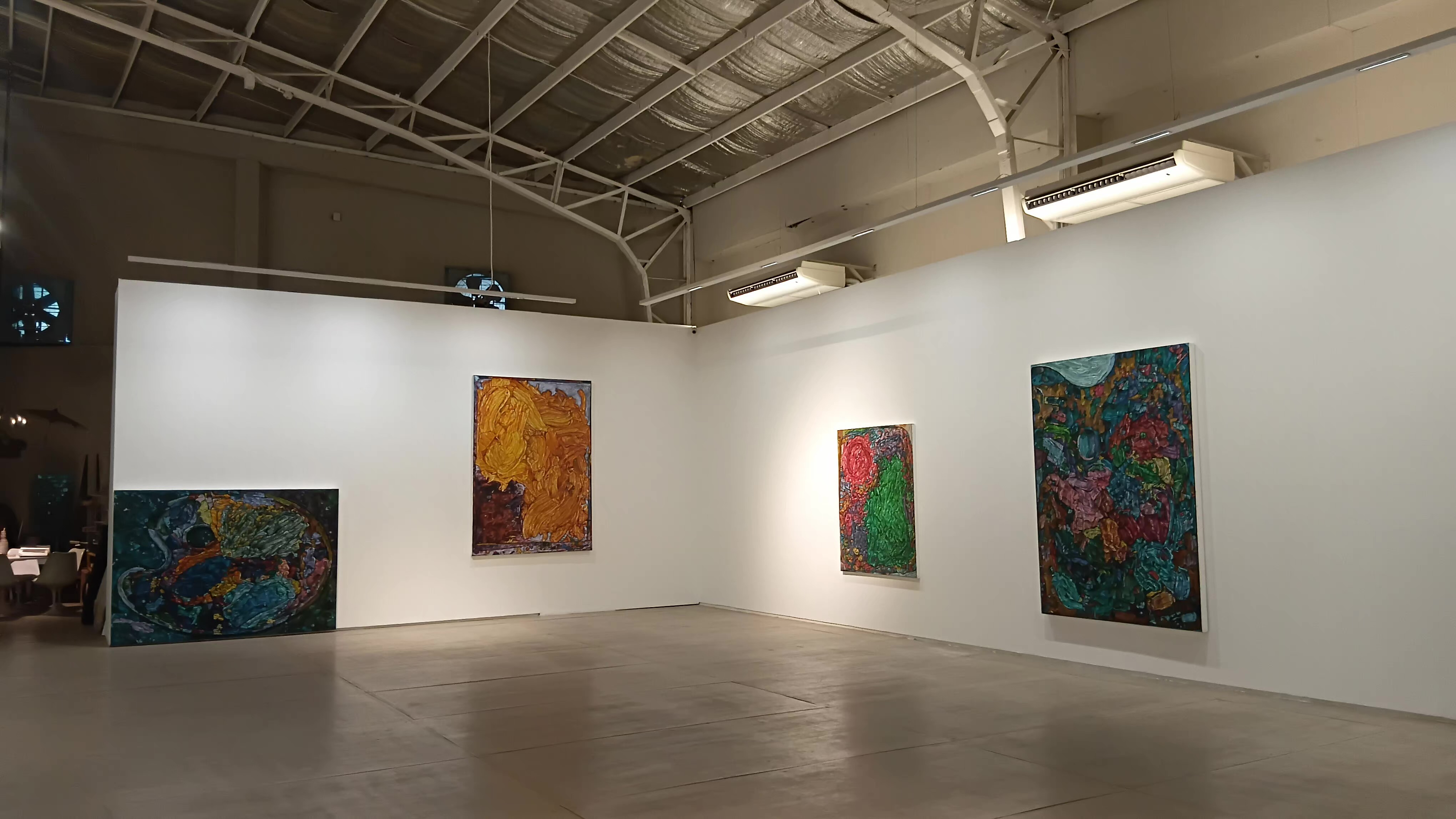The painter’s palette is a tool with a specific purpose to serve the final product—the artwork. Rarely are palettes thought of as ends in themselves. They are sites of incident and routine that precede the more intentional act of painting. We often ask painters about their process—how does the palette translate to the canvas? Yet rarely do we mind what the palette itself has to say.
Elaine Navas turned our attention to this often neglected, yet essential painter’s tool. In Each A Small Universe, she presented on large canvases the palette mixers of her fellow painters. Rendered in her intricate, painterly style, one might look at these subjects and not immediately recognize them. Large indiscriminate forms appeared to swim across her canvases in abstracted pools of color. The titles of each work bore simply the names of the artists whose palettes Navas rendered. Our viewing perspective was then reframed as these seemingly random swathes of colored disarray became reflections of the artists that formed them. In turn, we saw the way these blueprints of the process have their own sense of history while being objects of specific beauty in and of themselves.
Likely the easiest to recognize as a palette was “Yasmin,” named after Yasmin Sison. A plastic palette was covered with bright colors similar to the vibrant hues Sison uses in her works. Navas’s round strokes described the circular grooves of the palette, and we followed the paint as it flowed over onto the different areas of the mixer. Navas even suggested it spills out onto the floor. “Manuel O.,” after Manuel Ocampo, depicted another conventional palette. Its flat surface featured the darker hues that usually grace Ocampo’s works. Navas’s brushwork was both dynamic and precise while carrying a weight reminiscent of embroidery. In this weight was a sense of care. Not only did she recreate something personal to other artists and friends; she also interpreted a single snapshot in one’s creative process—one that likely will not be repeated again.
By looking in depth at the palette, “Each Small Universe” had us reconsider how we look at the different tools we work or come into contact with. As viewers, we have a conventional image of what a painter’s palette may look like: a flat, portable surface, usually with small compartments for holding different paint hues.
But in “Zean,” after Zean Cabangis, Navas depicted the artist’s unconventional palette mixer: a frying pan. Navas’s strokes brought to life ambiguously detailed forms. Both Navas and Cabangis recounted the complexities and curiosities of the painter’s life, where the most mundane of objects can be a breeding ground for creativity. In a postmodern art world, hardly are artists confined to a certain material or surface. It’s an unexpected thing of beauty, then, that one’s frying pan can become both an artistic tool and a source of inspiration as well.
Navas’s choice of subject was especially striking given her painting style. Her large, often highly detailed paintings are brought to life by optical mixing. In this phenomenon, colors mix in the eye of the viewer rather than on the canvas, allowing the artist more expressive freedom with their brushwork. Her individual strokes, painted layer upon layer, often have the rigidity of rocky terrain up close. From afar, they blend harmoniously. Like palette mixers themselves, Navas’s paintings highlight the mutability of form and color. Whether from afar or up close, a mass of red or blue could represent numerous different sights. Similarly, a drop of red or blue paint on our palette can create an almost unlimited array of images. With color mixing, there are no limits to what our eyes can perceive.
Navas’s choice of subject was especially striking given her painting style. Her large, often highly detailed paintings are brought to life by optical mixing. In this phenomenon, colors mix in the eye of the viewer rather than on the canvas, allowing the artist more expressive freedom with their brushwork. Her individual strokes, painted layer upon layer, often have the rigidity of rocky terrain up close. From afar, they blend harmoniously. Like palette mixers themselves, Navas’s paintings highlight the mutability of form and color. Whether from afar or up close, a mass of red or blue could represent numerous different sights. Similarly, a drop of red or blue paint on our palette can create an almost unlimited array of images. With color mixing, there are no limits to what our eyes can perceive.
In “Pow,” after Pow Martinez, all semblance of a traditional palette disappeared altogether. Two large bodies of red and green dominated her canvas as cool shades of violet and other hues skirted between them, as if caught in an ocean of colorful traffic.
With such obscure subjects and likely more obscure titles, one might wonder how we approach the show without any knowledge of the artists involved. Without knowing Pow Martinez’s animated color palette, what did Navas’s “Pow” tell us? An artist’s tools are often a reflection of themselves. The palettes on exhibit were essentially portraits of the artists they belong to. Navas, and by extension the artists, showed the contradictions and ultimate unpredictability of an artist’s life, captured in the fleeting moments seen in their palettes, often to be painted over, never to be recreated.
In the artist’s workspace, the painter’s palette harbors so much potential. As Navas’s works evoked, tapping into this potential reveals creative abundance that can help us see the palette in a new light, both literally and symbolically. In the diptych “Leslie,” and “De Chavez,” appropriately after Leslie De Chavez, the arch-like shape of his palettes resembled stained-glass windows; their messy heaps of paint turned into illuminated glass mosaics. When we view palettes like we do finished artworks, we can see them as reflections of the personal, or simply artworks in and of themselves—unintentionally made along the way, but nonetheless rich with meaning. As the artist stated in the exhibit notes, “The artist’s palette is like a small universe in its own right.”
There’s a circular conversation taking place in “Each A Small Universe.” Navas took this conversation from her own palette to her canvas, and ultimately back to the palette as a subject. The artist in turn projected a collaboration with her fellow artists to show intimate images of their own processes only their eyes are able to see. In the piece “Elaine,” Navas gave us a look at her own palette. An enthusiastic yellow engulfed nearly the whole canvas, showing us a brief moment for the artist where yellow overflowed. A palette can be a mixing tool, but it can also, however incidentally, be an artwork itself. If an artist’s palette is a universe, then what can our own working tools—our notes, files, message drafts—say about ourselves?
“Each A Small Universe” by Elaine Navas ran from February 15 to March 15, 2025 at The Drawing Room, Makati City.
Images taken by the author

